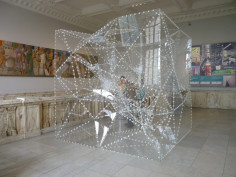SOU FUJIMOTO ARCHITECTS
على فوجيموتو
후지모토에
על פוג’ימוטו
на Фудзимото
inside outside tree

source: designboom
apanese architect sou fujimoto explores the boundaries between interior and exterior with ‘inside outside
tree’ currently on display as part of ‘1:1 – architects build small spaces’ at the V&A museum in london.
the structure is made from sheets of clear acrylic which have been cut into variously shaped polygons
and bound together using zip ties. the concept behind the work makes reference to ‘engawa’, the japanese
word for the platform that separates the house from the garden. in foujimoto’s work, the viewer can see
inside and outside at once. the cube shape connects to the tree form inside forming a single volume
surrounding the tree. fujimoto describes the piece as ‘a transparent tree shape but the tree is not a tree
but a void of tree’.
.
.
.
.
.
.
.
source: buenastareas
Sou Fujimoto (4 de agosto de 1971) es un arquitecto japonés, optó por reflexionar por sí mismo mediante la realización de pequeñas obras, lo que le da un carácter muy personal a sus proyectos que se caracterizan por utilizar formas básicas, generando una limpieza en sus composiciones. La casa N (Oita, Japón) fue diseñada y construida del 2006 al 2008 y compone una obra importante de este arquitecto, una casa para dos personas y un perro.
Los residentes habitan enmarcados en estos tres diferentes grados, parte de la propuesta nace de las dudas del arquitecto respecto a la dura solución de un muro que separa las calles de la vivienda, pensando en una solución de relaciones más graduales y de diferentes sensaciones de distancia con el exterior.
.
.
.
.
.
.
.
source: designersandbooks
Sou Fujimoto was born in Hokkaido, Japan in 1971 and studied architecture at Tokyo University. He established Sou Fujimoto Architects in Tokyo in 2000. The firm has designed many private residences in Japan and Europe, including the Primitive Future House in Basel, Switzerland (2008). In 2010, Fujimoto completed in Tokyo the Musashino Art University Museum and Library, based on the concept of a single spiral bookshelf, and the “132 5” store for Issey Miyake. Also in 2010 he designed the exhibition space for the acclaimed exhibition of Japanese fashion “Future Beauty,” at the Barbican Gallery in London.
The firm has garnered many awards, including the 2010 Rice Design Alliance Prize; the 2009 Wallpaper* magazine Design Awards for the Best New Private House (for Final Wooden House, Kamakura, Japan); and the winning award in the 2008 World Architectural Festival, Private House Category (also for Final Wooden House). The work of the firm was represented at the Venice Architecture Biennale in 2010. Fujimoto is currently Professor at the Illinois Institute of Technology. His 2008 book Primitive Future was the year’s best-selling architecture book.
.
.
.
.
.
.
source: m-art-dblogspot
ou Fujimoto (né en 1971) est un architecte japonais contemporain. Diplômé en 1994 de la faculté d’ingénierie de Tokyo, il dirige actuellement l’agence Sou Fujimoto Architectes, basée dans la même ville.
Après avoir fait ses études d’architecte à la faculté d’ingénierie de l’Université de Tokyo, il choisit de s’orienter pour le début de sa carrière dans de petits projets, qui viennent très vite caractériser son image. Il fonde en 2000 l’agence Sou Fujimoto Architects.
Il commence à se faire connaître en 2005 en remportant l’AR – Architectural Review Awards international prestigieux dans la catégorie Jeunes architectes, un prix qui lui a été décerné pendant trois années consécutives, et le Top Prize obtenu en 2006.
Il est invité en 2008 à faire partie du jury de ces mêmes AR Awards. Il remporte, toujours en 2008, le prix JIA (Japan Institute of Architects) et la plus haute reconnaissance au World Architecture Festival, dans la section Private House. En 2009, la revue Wallpaper lui a conféré le Design Award.
En 2008, Sou Fujimoto a publié « Primitive Future », le texte d’architecture best-seller de l’année. Son design architectural, toujours à la recherche de nouvelles formes et de nouveaux espaces entre la nature et l’artifice, continuera sans aucun doute à évoluer dans le futur. En 2012, il est exposé à la Biennale d’architecture de Venise au pavillon Japonais. On le considère comme l’un des plus intéressants jeunes architectes japonais apparus récemment, et son vocabulaire formel échappe à toutes classifications aisées.
.
.
.
.
.
.
.
source: museumlabjp
ふじもと・そうすけ/1971年北海道生まれ。1994年東京大学工学部建築学科卒業後、2000年に藤本壮介建築設計事務所を設立。2005年を皮切りに、若手建築家の国際的な登竜門である、AR awardを3年連続で受賞し一躍注目を浴びる。最近では、2011年の国際設計競技で「ベトンハラウォーターフロントセンター」及び「台湾タワー」で最優秀賞を受賞。主な著書に『原初的な未来の建築 Primitive Future』『建築が生まれるとき』『藤本壮介読本』がある。

